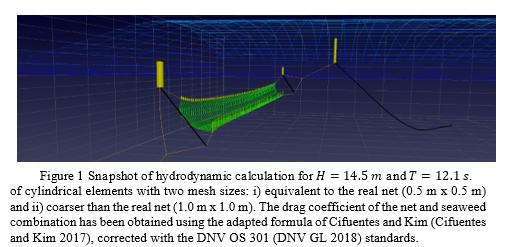NUMERICAL MODELLING OF THE DYNAMIC BEHAVIOUR OF A SIMPLIFIED SEAWEED Laminaria saccharina CULTIVATOR NET SYSTEM SUBJECTED TO WAVES AND CURRENT-INDUCED LOADS USING A LUMPED MASS APPROACH
Introduction
The multi-use concept for the North Sea, encouraged by the European Union, have brought up new commercial opportunities for the offshore and aquaculture sectors. The European Horizon 2020 UNITED (Multi-Use offshore platforms demoNstrators for boostIng cost-effecT ive and Eco-friendly proDuction in sustainable marine activities) project
appears as a joint effort between research and industrial partners to enhance aquaculture in the vicinity of offshore wind turbine parks. One of the activities within the UNITED project was the design of a seaweed cultivation net system for L aminaria saccharina (the design is owned by Offshore Seaweed Systems;
). The system will be installed at the FINO3 research platform
, located 45 nautical miles offshore in the German part of the North Sea. As part of the design process, a numerical study of a simplified seaweed cultivation net system was performed using a lumped-mass approach numerical model to evaluate the dynamic behaviour of the system subjected to waves and currents induced loads.
Theoretical Background
The two key parameters when modelling seaweed net systems is to correctly capture the hydrodynamic interactions of the net and the seaweed with the incident flow, respectively. The former has been studied mainly for fish nets by means of experimental testing
and numerical models based on dynamic 3D models
and the lumped-mass approach
. Cifuentes and Kim
, adapted the experimental drag coefficient formula estimated by DeCew and Tsukrov
validating it with experimental results improving the dynamic 3D models by addressing the influence of net solidity, , and Reynolds number, .
The latter has focused on experimentally obtaining the drag coefficients of a single blade of seaweed subjected to an unidirectional flow on a wave flume
. However, these experimental studies do not represent the behaviour of a net full of seaweed. To solve this limitation, the authors of this research propose to consider the growth of the seaweed in the net as biofouling on the net structure. Therefore, the drag coefficients of the net and seaweed combination will be adjusted based on the thickness of the seaweed following the recommendations of the DNV OS 301
for marine growth.
Numerical model
The numerical calculations have been performed using the in-house developed mooring dynamic solver MoorDyn-UGent, based upon the open source code MoorDyn
and adapted by Pribadi et. al
. A numerical net of 30 m length and 3 m width (for the cultivation of Laminaria saccharina) installed vertically supported by different buoys and clump weights has been modelled and subjected to different wave and current combinations . The net has been discretized as a combination of cylindrical elements with two mesh sizes: i) equivalent to the real net (0.5 m x 0.5 m) and ii) coarser than the real net (1.0 m x 1.0 m). The drag coefficient of the net and seaweed combination has been obtained using the adapted formula of Cifuentes and Kim
, corrected with the DNV OS 301
standards.
Results
Figure 1 shows a snapshot of the hydrodynamic simulation for a wave height, , and a wave period, , with a net discretization of 0.5 m x 0.5 m. In the numerical study performed it was observed that the numerical net discretization does not affect the tensions calculated on the anchor lines of the simplified seaweed cultivation net system. Furthermore, it was noticed that at the test site location, the major part of the load suffered by the system origins from the wave -induced hydrodynamic loads with a small contribution of the current-induced load.
Discussion and conclusion
A new numerical approach for calculating the mooring line tensions of a seaweed cultivation net system has been presented. This numerical approach is based on considering the growth of seaweed as fouling over a net following the DNV-OS 301 recommendations for cylindrical elements. The numerical results presented in this abstract will be validated against experimental data gathered during the UNITED project to assess the applicability of the numerical approach.
References
Cifuentes, Cristian and M. H. Kim. 2017. “Numerical Simulation of Fish Nets in Currents Using a Morison Force Model.” Ocean Systems Engineering 7(2):143–55.
DeCew, J., I. Tsukrov, A. Risso, M. R. Swift, and B. Celikkol. 2010. “Modeling of Dynamic Behavior of a Single-Point Moored Submersible Fish Cage under Currents.” Aquacultural Engineering 43(2):38–45.
DNV GL. 2018. DNVGL-OS-E301 Position Mooring.
FuE-Zentrum FH Kiel GmbH. 2021. “FINO3 - Research Platform.” Retrieved April 30, 2021 (https://www.fino3.de/en/).
Hall, Matthew. 2017. MoorDyn User’s Guide. Charlottetown, PEI, Canada.
Lader, P. F. and B. Enerhaug. 2005. “Experimental Investigation of Forces and Geometry of a Net Cage in Uniform Flow.” IEEE Journal of Oceanic Engineering 30(1):79–84.
Offshore Seaweed Systems. 2021. Cultivator Specifications 17th January 2021.
Pribadi, Ajie Brama Krishna, Luca Donatini, and Evert Lataire. 2019. “Numerical Modelling of a Mussel Line System by Means of Lumped-Mass Approach.” Journal of Marine Science and Engineering 7(9).
UNITED. 2021. “UNITED Project.” Retrieved April 30, 2021 (https://www.h2020united.eu/).
Vettori, Davide and Vladimir Nikora. 2019. “Flow-Seaweed Interactions of Saccharina Latissima at a Blade Scale: Turbulence, Drag Force, and Blade Dynamics.” Aquatic Sciences 81(4):61.
